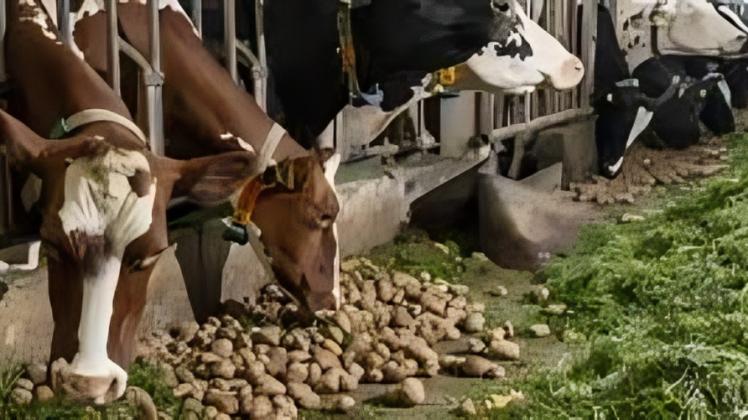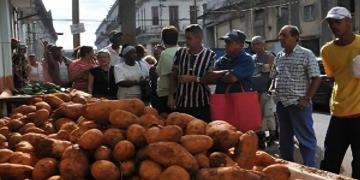Netherlands: Low prices mean more potatoes for farmers
Due to oversupply, large quantities of high-quality potatoes are currently used for animal feed. Wichert van den Berg, owner of Berg Agri, says farmers currently pay around €37.50 per tonne for potatoes.

Berg Agri ships large quantities of potatoes every week. According to owner Wichert van den Berg, this doesn’t happen every year. "In the last two years, there were few fodder potatoes for sale. This year, the quantities are enormous. This also translates into better prices for farmers."
According to Van den Berg, the size of the potatoes varies. "Because we currently have an oversupply, all types and sizes are being sold. We anticipate large potatoes for the new crop, as they were planted early this year and the growing season has been good."
Dry matter content
As a supplier of by-products, among other things, Berg Agri focuses on varieties with a high dry matter content. "Normally, potatoes that are unusable for human consumption after processing are used for animal feed. This is no longer the case, as they are being cleared to create space in the market," explains Van den Berg. "We ensure that farmers receive clean potatoes with a high dry matter content, free of clods and sand."
Jan Rozeboom, livestock nutritionist at ABZ Diervoeding, emphasizes the importance of feeding clean potatoes. "Potatoes with a lot of sand carry risks. For example, sand promotes the growth of harmful bacteria in the silage. This causes rot and fermentation, which ultimately leads to loss of shelf life."
The nutritionist explains that he prefers farmers to feed potatoes from the grading department rather than those from the washing plant. Potatoes from the washing plant are more prone to deterioration. He adds that the rate of feeding is also important. "Potatoes only last a few weeks; potatoes from the washing plant, in particular, should not be left for more than two weeks. If this is not managed, they will deteriorate and their nutritional value will rapidly decline."
Starch supplement
According to Rozeboom, potatoes are a valuable addition to grass rations. "They’re an excellent product for supplementing starch. They have good nutritional value and are therefore ideal for grass rations. Rations containing a lot of corn silage are already high in starch. Therefore, adding potatoes to grass rations offers less added value," says the ABZ Animal Nutrition nutritionist.
Rozeboom recommends consulting a feeding consultant. "Potato supplementation should be integrated into the ration. Potatoes are very cheap now, but if you don’t need them, they’re always too expensive. A feeding consultant can also help you decide on the feeding rate. You’ll need to consider how much to feed per day and how to stay within the desired ration."
The nutritionist explains that smaller farms, in particular, need to maintain a very high feeding rate to ensure timely potato production. "In these cases, the feeding consultant can also help determine whether it’s more appropriate to supplement the feed with other starchy products."
Potassium content
Another important point to consider, according to Rozeboom, is potassium content. "Potatoes have a fairly high potassium content. A cow can only tolerate a certain amount. If your pasture already has a fairly high potassium content, it’s best to supplement it with a low-potassium starch product, such as corn silage."
Rozeboom notes that potatoes are sometimes ensiled in corn silage. “Preservation softens the potatoes, allowing a cow to eat and digest them easily. However, it’s important that the silage not be too wet. Potatoes have a dry matter content of between 16% and 20%. All the water that escapes from the potatoes must be absorbed by the corn; otherwise, the preservation process will fail.”
The same goes for grass silage. Nutritionists often see spots of rot or mold on cattle. Therefore, short grass is best for preservation. "Chopped or autumn grass makes it easier to pass through and the silage becomes more airtight, which in turn optimizes preservation," explains Rozeboom.
Regarding milk production, feeding potatoes has a positive effect on milk production and protein content. Protein content, in particular, increases after feeding potatoes. Rozeboom: "Farmers who feed exclusively grass can achieve an increase in production and milk protein content by supplementing with potatoes."
Increased production
Farmer Anton de Groot from Harmelen, Utrecht, agrees. “I’ve been feeding potatoes all summer, and both the production and protein content of the milk have increased,” he says. De Groot’s dairy cows are outdoors during the day, and he feeds them in the evening. “First, I loosen the potatoes in front of the trough, then I collect fresh grass from the field. Afterwards, I feed them on top.”
According to the farmer, the only disadvantage of feeding potatoes is the selection process at the feeder. "They love potatoes, and the cows eat them with gusto. Often, they pick them first and only then start eating the grass," De Groot says, laughing.
Potatoes provide a selection in the feed fence.
Cows love potatoes. That’s the experience of Wichert van den Berg of Berg Agri; Jan Rozeboom of ABZ Diervoeding; and Anton de Groot, a farmer from Utrecht. "The disadvantage is that feeding potatoes leads to greater selection at the trough," says Leon Toonen, dairy farm vitalizer at Vitalvé. He points out that each cow is likely to consume a different amount of potatoes. "This unbalances the ration and increases the risk of ruminal acidosis. Cows that eat too many potatoes also consume more starch than they should. In the long term, this can lead to obesity." According to the vitalizer, an uneven ration can also lead to hoof problems in animals more quickly. "Hoof problems in cows are often the result of selective feed intake and insufficient balance in the ration. Therefore, the problems are not so much due to the potatoes themselves," explains Toonen.Fuente: nieuweoogst.nl




